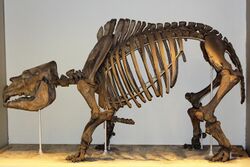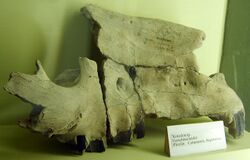Biology:Toxodontidae
| Toxodontidae | |
|---|---|

| |
| Toxodon platensis | |

| |
| Skeleton of Nesodon imbricatus | |
| Scientific classification | |
| Domain: | Eukaryota |
| Kingdom: | Animalia |
| Phylum: | Chordata |
| Class: | Mammalia |
| Order: | †Notoungulata |
| Clade: | †Eutoxodontia |
| Family: | †Toxodontidae Owen 1845 |
| Subfamilies and genera | |
|
†Haplodontheriinae
†Nesodontinae
| |
Toxodontidae is an extinct family of notoungulate mammals, known from the Oligocene to the Holocene (11,000 BP) of South America,[1] with one genus, Mixotoxodon, also known from the Pleistocene of Central America and southern North America (as far north as Texas).[2] Member of the family were medium to large-sized,[3] ranging from around 350–400 kilograms (770–880 lb) in Nesodon to 1,000–1,200 kilograms (2,200–2,600 lb) in Toxodon,[4] and had medium to high-crowned dentition, which in derived members of the group evolved into ever-growing cheek teeth.[5] Isotopic analyses have led to the conclusion that Pleistocene members of the family were flexible mixed feeders (both browsing and grazing).[6][7]
Taxonomy
The endemic notoungulate and litoptern ungulates of South America have been shown by studies of collagen and mitochondrial DNA sequences to be a sister group to the perissodactyls.[8][9][10]
In 2014, a study identifying a new species of toxodontid resolved the families phylogenetic relations. The below cladogram was found by the study:[11]
| |||||||||||||||||||||||||||||||||||||||||||||||||||||||||||||||||||||||||||||||||||||||||||||||||||||||||||||||||||||||||||||||||||||||||||||||||
References
- ↑ Turvey, Samuel T. (2009-05-28) (in en). Holocene Extinctions. OUP Oxford. ISBN 9780191579981. https://books.google.com/books?id=mbU-F42JU1AC&dq=Propaopus&pg=PA349.
- ↑ E. Lundelius, et al. 2013. The first occurrence of a toxodont (Mammalia, Notoungulata) in the United States. Journal of Vertebrate Paleontology, Vol 33, No 1, pp. 229–232 DOI:10.1080/02724634.2012.711405
- ↑ Cassini, Guillermo H.; Flores, David A.; Vizcaíno, Sergio F. (July 2012). "Postnatal ontogenetic scaling of Nesodontine (Notoungulata, Toxodontidae) cranial morphology: Nesodontine cranial allometry" (in en). Acta Zoologica 93 (3): 249–259. doi:10.1111/j.1463-6395.2011.00501.x. https://onlinelibrary.wiley.com/doi/10.1111/j.1463-6395.2011.00501.x.
- ↑ Nelson, Allison; Engelman, Russell K.; Croft, Darin A. (2023-07-12). "How to weigh a fossil mammal? South American notoungulates as a case study for estimating body mass in extinct clades" (in en). Journal of Mammalian Evolution. doi:10.1007/s10914-023-09669-1. ISSN 1064-7554. https://link.springer.com/10.1007/s10914-023-09669-1.
- ↑ Gomes Rodrigues, Helder; Herrel, Anthony; Billet, Guillaume (2017-01-31). "Ontogenetic and life history trait changes associated with convergent ecological specializations in extinct ungulate mammals" (in en). Proceedings of the National Academy of Sciences 114 (5): 1069–1074. doi:10.1073/pnas.1614029114. ISSN 0027-8424. PMID 28096389.
- ↑ MacFadden, Bruce J. (September 2005). "Diet and habitat of toxodont megaherbivores (Mammalia, Notoungulata) from the late Quaternary of South and Central America". Quaternary Research 64 (2): 113–124. doi:10.1016/j.yqres.2005.05.003. Bibcode: 2005QuRes..64..113M.
- ↑ Pérez-Crespo, Víctor Adrián; Arroyo-Cabrales, Joaquín; Guzmán, Ana Fabiola; Morales-Puente, Pedro; Cienfuegos-Alvarado, Edith; Otero, Francisco J. (2020-01-09). "ISOTOPIC PALEOECOLOGY OF A TOXODONT (MIXOTOXODON LARENSIS) FROM MICHOACAN, MEXICO". The Southwestern Naturalist 64 (1): 63. doi:10.1894/0038-4909-64-1-63. ISSN 0038-4909. https://bioone.org/journals/the-southwestern-naturalist/volume-64/issue-1/0038-4909-64-1-63/ISOTOPIC-PALEOECOLOGY-OF-A-TOXODONT-MIXOTOXODON-LARENSIS-FROM-MICHOACAN-MEXICO/10.1894/0038-4909-64-1-63.full.
- ↑ Welker, F.; Collins, M. J.; Thomas, J. A.; Wadsley, M.; Brace, S.; Cappellini, E.; Turvey, S. T.; Reguero, M. et al. (2015-03-18). "Ancient proteins resolve the evolutionary history of Darwin's South American ungulates". Nature 522 (7554): 81–84. doi:10.1038/nature14249. ISSN 0028-0836. PMID 25799987. Bibcode: 2015Natur.522...81W. http://eprints.whiterose.ac.uk/91438/1/Welker_postprint.docx.
- ↑ Buckley, M. (2015-04-01). "Ancient collagen reveals evolutionary history of the endemic South American 'ungulates'". Proceedings of the Royal Society B: Biological Sciences 282 (1806): 20142671. doi:10.1098/rspb.2014.2671. PMID 25833851.
- ↑ Westbury, M.; Baleka, S.; Barlow, A.; Hartmann, S.; Paijmans, J. L. A.; Kramarz, A.; Forasiepi, A. M.; Bond, M. et al. (2017-06-27). "A mitogenomic timetree for Darwin's enigmatic South American mammal Macrauchenia patachonica". Nature Communications 8: 15951. doi:10.1038/ncomms15951. PMID 28654082. Bibcode: 2017NatCo...815951W.
- ↑ Forasiepi, A. A. M.; Cerdeño, E.; Bond, M.; Schmidt, G. I.; Naipauer, M.; Straehl, F. R.; Martinelli, A. N. G.; Garrido, A. C. et al. (2014). "New toxodontid (Notoungulata) from the Early Miocene of Mendoza, Argentina". Paläontologische Zeitschrift 89 (3): 611–634. doi:10.1007/s12542-014-0233-5. http://sedici.unlp.edu.ar/handle/10915/127531.
Further reading
- McKenna, Malcolm C., and Bell, Susan K. 1997. Classification of Mammals Above the Species Level. Columbia University Press, New York, 631 pp. ISBN:0-231-11013-8
External links
Wikidata ☰ Q846394 entry
 |


